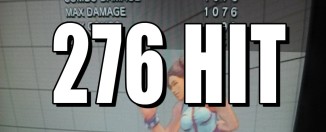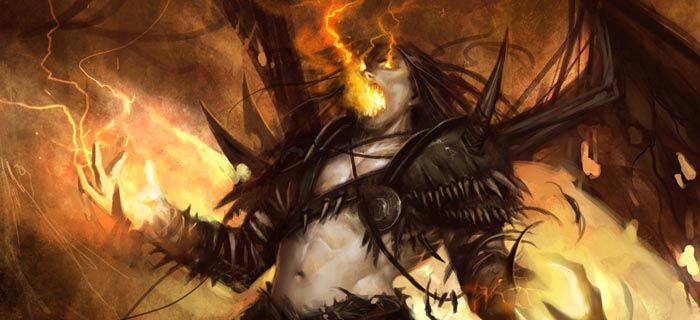Your move, entire fighting game industry
 In this “review” of Mortal Kombat, we look at all the reasons you should stop reading this article and go buy Mortal Kombat this instant. Is the game perfect? By no means. But if it represents anything, this Mortal Kombat iteration represents a new direction available to fighting games. Will others follow suit? Get over here and find out why they should.
In this “review” of Mortal Kombat, we look at all the reasons you should stop reading this article and go buy Mortal Kombat this instant. Is the game perfect? By no means. But if it represents anything, this Mortal Kombat iteration represents a new direction available to fighting games. Will others follow suit? Get over here and find out why they should.
Story mode
While some games like Blazblue have done their best to leverage lengthy cutscenes to set up their characters’ tales, the fact of the matter is that the vast majority of games in the genre completely fail at delivering an engaging single player experience. In Super Street Fighter 4, the current prettyboy of the fighting community, single player arcade mode is much like it is in most of its contemporaries:
- Intro story animation*
- Fight a random enemy for no reason
- Repeat Step 2 several times
- Fight a sub boss (in this case, your “rival”)
- Fight the final boss
- Ending story animation
Simply put, it sucks, and unfortunately most fighting games are like this. If there is a story, it’s incredibly hard to follow in such a limiting presentation, and the very nature of this schemata means the greater part of the endings aren’t canon, since the next iteration in the series can’t very well assume every fucking character beat Seth.** Don’t get me wrong, there are much worse single player experiences, such as Soul Calibur IV’s “is it in yet?” over-before-you-started experience. But the bar hasn’t really been set particularly high.
What makes Mortal Kombat’s Story Mode so engaging is that it’s completely continuous. Instead of choosing a character (and therefore outright ruining any sense of continuity or lore right off the bat), Story Mode tells the story of Mortal Kombat. In short, Earthrealm must defend itself from the Outworld invasion using the Mortal Kombat tournament as a proxy to determine the future of our dimension. At some point in the future Earth loses, everyone dies, and Apple Jacks start tasting like apples, so the god of thunder goes back in time to try to save our planet. As the story progresses, you play as different characters as each becomes the main action-driving figure in the plot. This is refreshing for two reasons: you’re forced to learn multiple characters and the events that occur all have reasonable context. Fights load during in-game engine cut scenes, meaning when Johnny Cage and Jackson Briggs start hitting each other, odds are this is the point where you take the reigns and settle the argument.
There is no other way to put it: Mortal Kombat’s single player story mode is unsurpassed. And while story doesn’t really matter in a fighting game in the long run, the amount of effort, detail, and (dare I say it?) fun involved makes you wonder why other developers (Arc System Works excluded) seem to give precisely 0.00 shits about the at-home experience.
Online play
I won’t sugar-coat it, so far the online experience of Mortal Kombat has been hit-or-miss as far as latency is concerned. Some games have been flawless, while others have stuttered and disconnected. However, many fighting games experience online jitters in their first week or so after launch due to high player volume, developer netcode tweaks, and other factors.†
Until a few weeks have passed, it won’t be fair to judge the experience on initial latency, so let’s look at the other features: they are awesome.
Yes, there are still player matches and ranked matches, and unlike in Super Street Fighter IV, you can’t choose your opponent in ranked matches (you know, since that defeats the entire purpose of ranked matches). Additionally, there’s the much-lauded King of the Hill mode, which is a multiplayer lobby with all the fixings. While Marvel vs Capcom 3’s designers saw fit to exclude spectators from its player lobbies (despite the feature existing in Super Street Fighter IV and pretty much every other fighting game), Netherrealm Studios raises the bar in Mortal Kombat by putting the action on display in front of the waiting players’ avatars, where they can cheer, boo, and rate each match as it’s happening. Fighters oozing with style will earn extra Respect Points from their compatriots, and the dueling duo on screen always has the option to hide the onlookers for more focused full-screen action.
In addition to King of the Hill, Mortal Kombat’s online component has fucking chat rooms. Yes, that’s right, those things from the 90s. By joining a chat room, you can chat with other players (either typing out messages or defining and using your own lengthy presets), see their records, challenge them to 1v1, 2v2, or King of the Hill matches, and more. These rooms take all the guesswork out of casual matchmaking, since you can see who’s in a game, who’s not, and who will most likely stomp your ass into the ground. While the actual chat feature is more of a side note, it’s a pleasant surprise to be able to easily congratulate your last foe with a GG or to publicly mock a disconnecter in front of everyone else.
Much like the single player experience, Mortal Kombat’s online modes leave little to be desired, reinforcing the image that the developers poured their souls (and no doubt the souls of many others) into creating an engaging experience with endless replay value and customization.
The actual gameplay
As with launch window lag, things like long-term balance and competitive potential aren’t truly discernible from the get-go, though I believe Mortal Kombat has the tools to develop a serious fighting community. While MK’s system will probably feel fairly foreign to fan of other “2D” fighters, devotees of Tekken and most “3D” games with a block button will grasp it much more quickly. And of course, anyone who has followed the Mortal Kombat franchise in all its (sometimes disappointing) iterations should be right at home. That said, there’s plenty of common ground with Capcom’s offerings: throws are performed with both light attacks simultaneously, there’s a mix of cancel and link combos, and everyone plays as the two guys on the cover of the box.
Pacing in Mortal Kombat is very aggressive. All attacks do chip damage, meaning that turtling is ultimately not a viable full-round strategy. Additionally, blocking attacks gives your opponents additional super meter, which can be spent to perform enhanced special attacks (very similar to EX attacks in SSF4), c-c-c-combo breakers, or x-ray attacks, which are in essence highly violent Ultra Combos. Of course, this gauge also fills as you perform special moves or take damage, meaning fights quickly progress from fast to brutal as each player’s character takes and dishes out damage. While the merits of comeback mechanics like the x-ray are debatable, they are somewhat mitigated by the existence of combo breakers and the fact that super meter carries over between rounds.
In addition to high-damage combos and chip damage, fighting is accelerated by the fact that nearly every kombatant has a projectile and/or a teleport. There really isn’t anywhere on the screen that’s safe to be, and when spamming one move could get you caught in a 60% damage combo from anywhere on screen, fights tend to revolve around mid-range positioning and relatively safe, hit-confirmable pokes.
All fighters have the same amount of life, so Netherrealm Studios can always counter claims of chauvinism with the equal opportunity beatings offered by its plentiful female cast. While a few characters stand out as slightly stronger or weaker than the average, Ed Boon has stated on numerous occasions that Mortal Kombat was designed for balance and continuous balance updates, which is a breath of fresh air amidst Ono-san’s insistence that unbalance and super strong characters make fighting games more fun. Overall, this game feels balanced, though once again, only time will tell.
Presentation
The gist of the matter, if you can’t tell by now, is that Mortal Kombat is an extremely polished offering from top to bottom. Every game mode feels well-planned and well-executed, including simple items like unlocking extras. Where some games skimp, MK delivers, giving players hundreds of costumes, art pieces, music tracks, and other surprises to discover. Off the top of my head, only Super Smash Brothers Brawl featured a more engaging unlock system.
Graphically, the game looks very good. Some character models could have used a little more texture work (Liu Kang’s incredibly odd looking nipples come to mind), but the overall scope and detail of the game is impressive. Backgrounds harkening back to MKI and MKII days are brought to life with renewed depth, gore, and style, and special effects utilize lighting and physics in realistic and oftentimes sickening ways. Mortal Kombat is one of the few fighting games to feature battle damage, meaning characters will look like they’ve taken quite a beating after they’ve taken quite a beating. This stands in bright contrast to fighters in which in-game personas who have just been thrown into cement face first finish the match looking like super models. Mortal Kombat, true to its lineage, still isn’t shy about blood and gore, and fighters will finish rounds completely soaked in their opponent’s and their own bodily fluids. Ed Boon pointed out in several interviews that the blood on each character is dynamically generated based on where it actually splatters during the fight, and that it also ages slowly, turning slightly darker brown as it is exposed to air for longer periods of time.
Of course, it wouldn’t be Mortal Kombat without the ability to utterly destroy and humiliate one’s opponent, and each fighter has at least four ways to finish a defeated nemesis. I won’t spoil the details of what they entail, but the finishers are just what you’d expect: sadistic, over-the-top, and hilarious. That said, they remain optional for players who are a bit squeemish about bathing in another person’s entrails, even despite recent clinical research demonstrating the benefits of a bi-monthly bloodbath.
Summary
The article title pretty much says it all: Mortal Kombat has set a new standard for what a fighting game can and, arguably, should be. The amount of things to do and the quality with which they’re executed is staggering, leaving most other fisticuffs simulators looking paltry by comparison. While the game has some flaws, including some preliminary online latency and a few muddled textures here and there, the overall package is one that actually feels like it’s worth $60. If that isn’t a sell in a genre typically defined by milking and over-all-too-soon gameplay experiences, I don’t know what is.
*The term animation is used very, very loosely here.
**Or, if it can, fuck everything about this plot.
†In the case of Soul Calibur IV, that factor is terrible coding.







I demand a Portal 2 review.
/runs away
I’d like to but I haven’t played co-op yet. Plus, let’s not kid ourselves: you all bought Portal 2. Is there a point in reviewing it?
WiNG, if over the weekend you have time, might we try a Portal 2 co-op run? I haven’t even downloaded the game to my HD yet, so my noobishness (and your inevitable trolling of me) should make for some very interesting video.
I think it’d be fun. For you. And science.
Not really, though I’d like to know your opinion about it. But do as you wish; as you said, pretty much all of us bought it, so…
Great review, I’ve been thinking about picking up this game.
(And *I* haven’t bought Portal 2 yet…waiting till it goes on sale.)
I really wish I knew more about the fighting game genre. I played MK as a kid without really knowing anything. My memories, while fond, do no service to the series or the genre. That said, I feel like I invest enough time into my shooter and RPG game to branch out much more and stay sane. I’m glad that this reboot of MK did the series justice and moves the industry forward. It seems that so few developers understand what it takes to make a game that breaks new ground or that has design decisions that make gamers and other developers think. Of course, if you’re Bobby Kotick, money is all that matters, and so innovation is that big scary gorilla that he feeds the souls of indy developers.
Hiss! You weren’t supposed to say his name aloud!
Goddamn did I forget how compelling a writer you are.
I’ll take your compliment and raise you a BEER. What will you do now, Bill?
PS: TWO!
I didn’t buy portal 2.
Or this
So help me god.
So no one here’s gonna ask why you were looking at Liu Kang’s nipples? Are they that odd that you can’t help but look at them?
They burned into my retinas like a thousand flaming suns.
http://media.otakuzone.com/store/user/181025/T129992581289f093fe09fb968ac9dc405c0ba3d9685f.jpg
Wait, what?